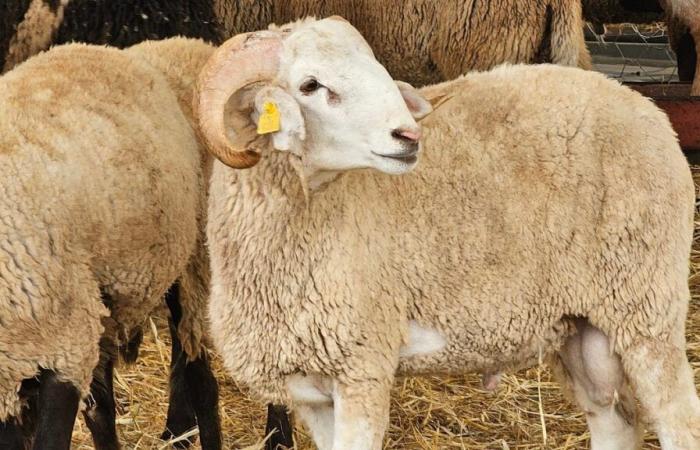Sheep prices in Algeria are soaring to unprecedented levels. If the irregularity of the rains is largely responsible for the lack of fodder, breeders point the finger at the flour mills. These would speculate on the sale of wheat bran.
At the weekly livestock markets, many testimonies from breeders express their concerns about the cost of barley and bran needed to feed their sheep, the price of which can reach 140,000 DA. An order of magnitude, the minimum wage is currently 20,000 DA.
Already, in the summer of 2023, breeders confided their difficulty to the Tiaret New web channel. A breeder called on the authorities to “ strike with an iron fist, otherwise the livestock is threatened with extinction ».
This breeder let his dismay show: “ How is it that we are only entitled to one quota of barley per year, while at garage level [ceux des marchands privés] it is 7,000 DA per quintal? »
The breeder continued: “ I have 34 years of experience and all my income comes from breeding to feed my 7 children. We can't do it anymore, the State must do something. I raise sheep all year round and my children help me and are deprived of everything, television and even fresh lemonade. Having a refrigerator is not possible when you are a nomad ».
Another breeder testified: “ The problems are with the flour mills and the dock [la CCLS qui affecte les quotas d’orge]. It is up to the State to carry out checks ».
The census of the sheep herd carried out in 2023 made it possible to detect some of the false declarations and the attribution of barley to these false breeders. What remains is the sound coming from the flour mills.
Insufficient fodder supply
Traditionally, the steppe supports herds of sheep, but drought and overgrazing have undermined these fodder reserves.
The value of these pastures can reach 300 fodder units (UF) per hectare, the equivalent of 300 kg of barley. A free fodder offer which attracts covetousness although the average is 150 UF, but in recent years, it has fallen to 60 UF according to the agricultural services of Naama.
Breeders with means of transport are currently taking advantage of steppe pastures which have greened up after the rains, as is the case in the wilaya of Béchar.
Those who can afford it feed their animals with fodder grown under irrigated conditions. For others, the current scarcity of fodder availability means that their only solution is to use more barley and wheat bran.
Many breeders complain about the prices charged by flour mills. Although the price of bran is capped at 1,800 DA per quintal, some flour mills sell it at a rate of 4,700 DA while on the invoices issued the price indicated is 1,800 DA.
At the request of mill owners, the old regulated sales price previously set at 1,500 DA per quintal was revalued. It rose to 1,800 DA in 2022. But nothing is happening, flour mills persist in charging excessive prices according to the testimony of breeders.
Flour mills are not obliged to sell all of the bran they produce at a regulated price, but only a part.
In June 2022, the Ministry of Agriculture and Rural Development announced that: “ Units specializing in the milling of soft and durum wheat will be required, from next season, to redistribute 60% of the quantities of bran from processing operations to livestock breeders. ».
On this occasion, the Minister of Agriculture declared before the National People's Assembly (APN) that he wanted all the bran produced by flour mills to be sold at the regulated price of 1,800 DA.
Flour mills, profitable activities
In April 2024, the Minister of Agriculture and Rural Development, Youcef Cherfa specified during an intervention before the APN that a total quantity of wheat “ estimated at 29 million quintals in 2023 » had been distributed to the flour mills.
At a flour extraction rate of 75% per quintal, the remaining 25% constitutes milling products including wheat bran.
In 2023, these milling products therefore amounted to an average of 7.25 million quintals. The sale of 60% of these at an average speculative price of 4,500 DA represents a gain of almost 20 billion DA compared to only less than 8 billion DA at the regulated price of 1,800 DA.
With a differential of 12 billion DA between the two sums, this amount therefore corresponds to the equivalent of 600,000 SMIC illegally received by the flour mills.
The lack of natural fodder and the high price of livestock feed have led breeders to sell some of their animals. A situation which resulted in the slaughter of sheep.
This would explain the current shortage of small lambs a few days old and their price which reaches 35,000 DA at a time when breeders specializing in fattening for the month of Ramadan are looking for animals.
On November 12, on the cattle market of Bougtob (El Bayadh), a breeder claimed that he had received an offer of 25,000 DA to sell a three-day-old lamb and that he was asking 35,000 DA to sell it. A price that shocked Algerians.
In May 2023, the Minister of Agriculture had to remind that the slaughter of sheep was prohibited. “ We will present as soon as possible a bill criminalizing the slaughter of female livestock such as sheep and cows. » he declared.
At a rate of 2,800 DA per kilo, the consumer is not sure of finding sheep meat at an affordable price unless they turn to sheep meat from Romania at a price of 1,900 DA.
ON THE SAME SUBJECT:
Which sheep gives the best meat?






